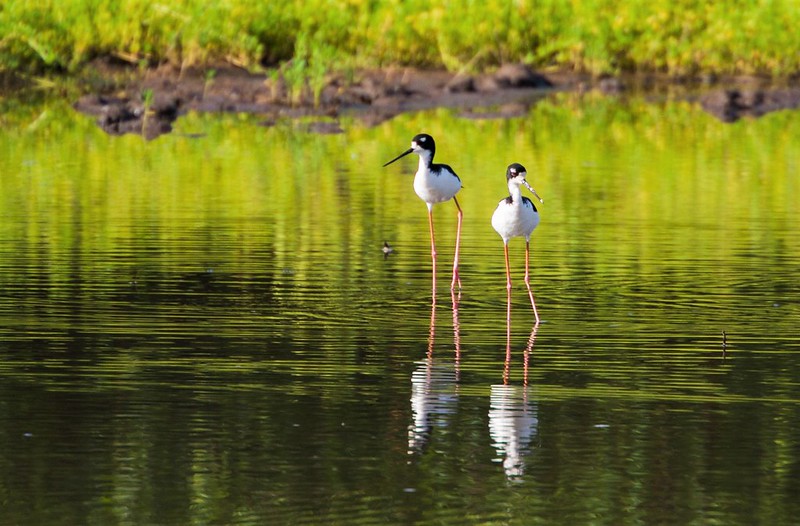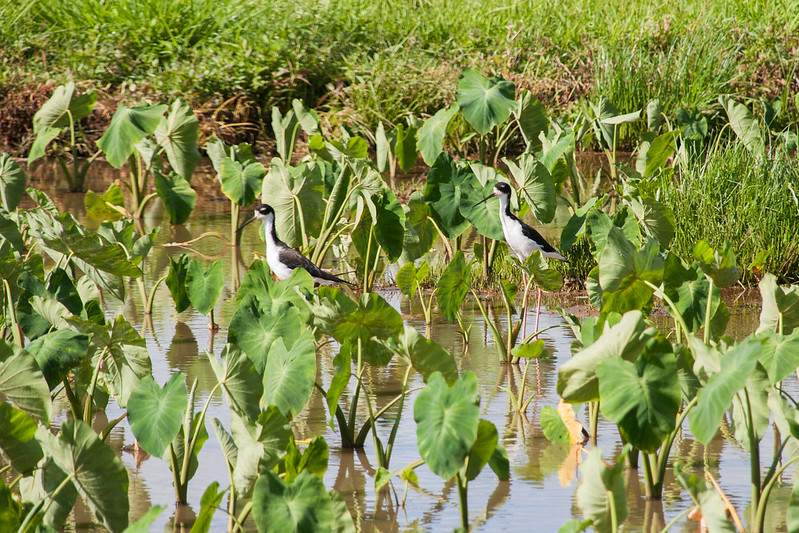Strong Conversation Efforts Lead to Proposal To Downlist Endangered Hawaiian Stilt to Threatened
The US Fish and Wildlife Service is proposing to downlist the aeʻo (Hawaiian stilt)from endangered to threatened under the Endangered Species Act. The Service is seeking public comment on the proposed change in status for the aeʻo from March 24 – May 24.
The Endangered Species Act (ESA) defines endangered as a species that is currently in danger of extinction throughout all or a significant portion of its range. Threatened is defined as likely to become endangered in the foreseeable future.
The aeʻo is a wading bird that occurs on all the main Hawaiian Islands, except Kahoʻolawe. It was originally listed as endangered in 1970 due to destruction and alteration of habitat, hunting, introduced predatory animals and non-native birds and disease.
Over the past three decades, diverse stakeholders have come together to manage the Hawaiian wetlands in ways compatible with the needs of the aeʻo and in addressing other threats. These efforts include the state of Hawaiʻi working with national wildlife refuges to manage wetlands on behalf of the stilt and other species that share its habitat.
Aeʻo rely on wetlands to raise their young, forage for food, and rest. Wetlands are increasingly rare across Hawaiʻi and state managed wetlands and national wildlife refuges like Kealia Pond National Wildlife Refuge on Maui, James Campbell National Wildlife Refuge on O’ahu and Hanalei National Wildlife Refuge on Kauai have played essential roles in providing these birds the habitat they need.
Aeʻos are beautiful, black and white birds with long pink legs – longer in proportion to its body size than those of any bird except the flamingo. They are popular with birders and anyone lucky enough to view them.
The proposed downlisting is an example of the power of conservation partnerships between federal, state and private stakeholders under the ESA.
“The Service is proud of our record of partnering with diverse stakeholders to conserve and recover imperiled species,” Regional Director Robyn Thorson said. “We look forward to continuing the collaborations that have led to the improved status of the aeʻo and the countless other species that share its habitat.”
Acting Service Field Supervisor Mary Abrams added: “State managed wetlands and national wildlife refuges have been essential for the recovery of the aeʻo. The State of Hawaiʻi and other conservation partners have been key in helping the aeʻo move toward recovery. Protected wetlands and continued invasive predator control are essential for protecting the bird into the future.”
There are remaining challenges to recovery of the aeʻo, including non-native animal predation (e.g., mongooses, cats and rats), habitat loss, development, type C botulism and the effects of climate change. Survey data and a recent population viability analysis indicate that populations have been stable to increasing for several decades in the eight islands where it exists. These trends are expected to continue into the foreseeable future, as long as conservation efforts continue. These practices include predator control, management of vegetation and water levels.
The proposed downlisting includes a proposed 4(d) rule that facilitates conservation and management of Hawaiian stilts where they currently occur and may occur in the future through increased flexibility by removing the federal take prohibition under certain conditions. These flexibilities are aimed at encouraging support for habitat management and providing federal and non-federal entities with a way to reduce human-wildlife conflicts.
Comments on the proposed rule must be received prior to or postmarked by May 24 and may be submitted electronically to the Federal eRulemaking portal at http://www.regulations.gov, or via U.S. mail or hand-delivery to: Public Comments Processing, Attn: FWS–R1–ES–2018–06571, U.S. Fish and Wildlife Service, MS: BPHC, 5275 Leesburg Pike, Falls Church, VA 22041-3803.
All comments and materials received become part of the public record associated with this action. Before including your address, phone number, email address or other personally identifiable information in your comments, you should be aware that your entire comment—including your personally identifiable information—may be made publicly available at any time.


















